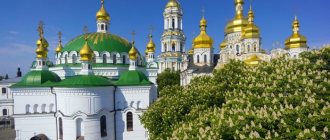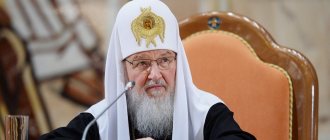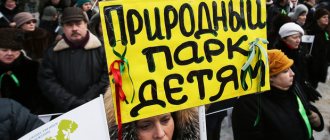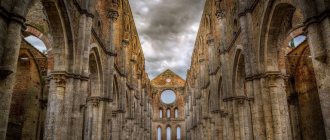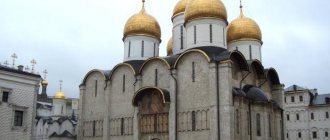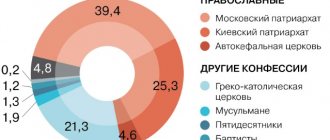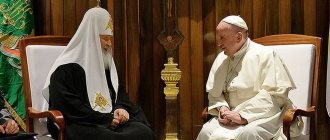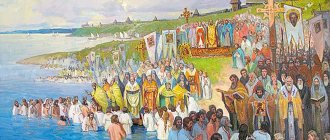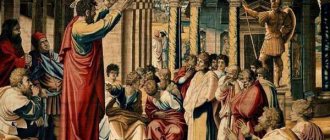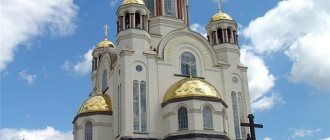Primates
[7]
- St. Apostle Mark the Evangelist (c. 42 - April 4, 62/63)
- St. Anian (c. 62/63 - November 16, 83/84)
- St. Avilius (c. 84 - February 22, 95/98)
- Kidron (c. 98 - June 5 105...109)
- Prim (c. 110 - July 17, 121)
- St. Just (c. 121 - c. 130)
- Eumenius (c. 130 - 143)
- Mark II (Marcian) (c. 144 - January 1, 149...154)
- Keladion (Kelladium) (c. 154 - July 3, 164...167)
- Agrippin (Agrippa) (c. 167 - January 30, 180)
- Julian (Julius) (180 - March 4, 189)
- St. Demetrius (189 - October 8, 231)
- St. Herakles (231/232 - 247)
- Sschmch. Dionysius the Great (247/248 - September 10, 264/265)
- St. Maxim (Maximinian) (264/265 - April 9, 282)
- St. Feona (282 - August 23, 300)
- Sschmch. Peter I (con. 300 - November 25, 311)
- St. Achilles (311 – 312/313)
- St. Alexander I (c. 313 - April 19, 328)
- St. Athanasius the Great, 1st time (328 - 336)
- Pist
, Arian (c. 337 - c. 338) - St. Athanasius the Great, 2nd time (November 23, 337 - March 19, 339)
- Gregory the Cappadocian
, Arian (339…341 – 344…346) - St. Athanasius the Great, 3rd time (October 23, 346 - February 9, 356)
- George the Cappadocian
, Arian (February 24, 357 - October 2, 358, November 26 - December 24, 361) - Lucius
, Arian (con. 361) - St. Athanasius the Great, 4th time (February 21 - October 24, 362)
- St. Athanasius the Great, 5th time (beginning 364 - May 4, 365)
- Lucius
, Arian, 2nd time (December 365) - St. Athanasius the Great, 6th time (February 1, 366 - May 2, 373)
- Peter II (373 - 374)
- Lucius
, Arian, 3rd time (375 - May 30, 378) - Peter II, 2nd time (379 - February 14/15, 380)
- St. Timothy I (380 - July 20, 384)
- Theophilus I (384 - 412)
- St. Cyril the Great (October 17, 412 – June 27, 444)
- Dioscorus I
, Monophysite (444 - September 1, 451) - St. Proterius (November 451 - March 28, 457)
- Timothy II Elur
[8], Monophysite (March 457 - January 460, c. 475 - July 31, 477) - Timothy III Salofakiol [9] (June 460 - December 475, September 477 - June 482)
- Peter III Mong
, Monophysite (summer 477 - September 4, 477, December 482 - October 29/31, 489) - John I Talaya (June 482 - December 482)
- Athanasius II Kilit (489/490 - September 17, 496/497)
- John II Melis
, Monophysite (496 - April 29, 505...507) - John III Nikiot
, Monophysite (c. 507 - May 22, 516/517) - Dioscorus II
, Monophysite (516/517 - October 9, 517...520) - Timothy IV
, Monophysite (c. 520 - February 7, 535...537) - Theodosius I
, Monophysite (from 535…537) - Gaina (Gyan)
, monophysite (from 535…537) - Paul Tavennisiot (c. 539 - 540/541)
- Zoilus (c. 541 - July 551)
- St. Apollinaris (551 - ca. 568)
- John IV (c. 569 - c. 579)
- St. Eulogius (c. 580 - February 13, 607/608)
- Sschmch. Theodore I (Theodosius) Skrivon (607/608 - December 3, 609)
- St. John V the Merciful (609/610 - 619/620)
- George I (c. 621 - c. 630)
- Cyrus, Monothelite (630/631 - 642...644)
- Peter IV (642...644 - 651...654)
- widowhood of the department
?
(c. 1665 - c. 1667)
(21 March 1869 - June 1870)
Content
- 1 History 1.1 Early history
- 1.2 Division of the Alexandrian Church after the Council of Chalcedon
- 1.3 During the period of Arab domination and the Crusades
- 1.4 During the period of Turkish rule
- 1.5 Alexandria Church in the 19th century
- 1.6 Alexandria Church in the 20th century
- 2.1 Dioceses of the Patriarchate of Alexandria
Dioceses
[6]
See also Episcopate of the Alexandrian Orthodox Church; Historical dioceses of the Alexandrian Orthodox Church
- Archdiocese of Alexandria
- Aksumite
- Accra
- Antananarivo
- Botswana
- Brazzaville
- Burundian
- Guinean
- Dar es Salaam (Irinopol)
- Ermopolskaya
- Zambian
- Zimbabwean
- Iliopolskaya
- Johannesburg (Johnnopolis)
- Cameroonian
- Kampala
- Carthaginian
- Katangese
- Kanangskaya
- Cape Town (Cape of Good Hope)
- Kinshasa
- Kirinskaya
- Leontopolskaya
- Mwanzinskaya
- Memphis
- Nairobi
- Nigerian
- Nilopolskaya
- Nubian
- Pelusian
- Ptolemaidan
- Tripoli
- Arusha
- Bukobskaya
- Gominskaya
- Guluskaya
- Kisangana
- Kisumskaya
- Malawian
- Mozambican
- Nyeri
- Tuliyarskaya
- Eldoret
Metropolises
Bishoprics
Patriarchate of Alexandria. Recent history (from 1935 to the present day)
After the death of His Beatitude Patriarch Meletios Metaxakis (+1935), who was one of the most prominent and active patriarchs of the modern era; and to whom the Alexandrian Church owes its revival, namely the establishment of the synodal system, the establishment of a church-administrative structure throughout the African continent, the creation of metropolises, the construction of new churches and charitable institutions (schools, hospitals, orphanages, orphanages, etc.), on Metropolitan Nicholas V of Ermupolis ascended the throne of St. Mark.
NICHOLAS V (1935 – 1939)
Under Nicholas V, a new method for electing the head of this Church was established in the Patriarchate of Alexandria.
After the death of Patriarch Meletius in 1935, the Local Council of the Alexandria Church, convened to elect a new primate, opened its work. The election procedure had to take place in accordance with the laws of the Egyptian state in force at that time. However, Orthodox Syrians began to protest about the method of electing the patriarch and achieved a postponement of the election of the new head of the Church. As a result, the Egyptian Ministry of Foreign Affairs presented the Patriarchate with a written document that contained new provisions for the election of the Patriarch. Elections were considered legal if the following conditions were met:
- Compliance with the laws of the Egyptian government and the consent of interested parties, including the Syrian Orthodox.
- The latter should be included in the management of church property.
- Appointment of another Syrian bishop.
- The organization of ecclesiastical courts must be sanctioned by the Egyptian government. In this case, the opinions and demands of the Syrian Orthodox must be taken into account.
- The patriarch must accept Egyptian citizenship if he did not have one.
The patriarch's locum tenens disagreement with these demands led to the Egyptian government's non-recognition of the results of the patriarch's election.
The new head of the Alexandrian Church was elected subject to the above conditions. This happened on February 11, 1935. Metropolitan Nicholas V of Ermupolis became the new patriarch.
After the elections, the patriarch instructed a mixed commission, which consisted of Greeks and Syrians, to study in detail the question of the procedure for electing the head of the Church.
The commission worked for a long time, which led to the belated recognition by the Egyptian authorities of the results of the election of a new patriarch, which only happened in March 1937, when a new rule was adopted on the election of the head of the Alexandrian Church. This rule stated that Orthodox Christians in the Syrian diaspora take part in the election of a new patriarch on equal terms.
Nicholas V was a zealous follower of the principle of conciliarity in the governance of the Church. He worked with insatiable energy to reorganize the patriarchy according to this principle. He also paid great attention to church educational institutions. He managed to transform relations with the Egyptian government into cooperation and mutual understanding. Unfortunately, the patriarchate of Nicholas V did not last long, and therefore he did not have time to carry out his work to the end.
CHRISTOPHER II (1939 – 1967)
Metropolitan Christopher II of Leondopolis was elected to the patriarchal throne on July 21, 1939 by the Local Council of the Church of Alexandria.
Before his election, he promised to fill all the dowager chairs of the Alexandrian Church, improve the financial situation of the priests, and much more. However, the new political conditions in which the Patriarchate of Alexandria found itself after the end of the Second World War, when the flow of Greek emigration to other countries, especially Australia, increased, led to a strong reduction in the Greek flock in Egypt. The changes that took place in this region plunged the country into chaos and led to the oppressed position of the Greek diaspora and the Patriarchate of Alexandria. Thus, the once thriving Greek community of Egypt, which represented the support of the Patriarchate on the African continent, by the end of the 60s of the twentieth century began to number only a few thousand people.
Despite this, Patriarch Christopher continued to work energetically for the good of the Church, overcoming the difficulties that arose. He was able to achieve the elimination of divisions and strife within Christian communities, which for decades had troubled the life of the Church.
On the issue of recognition of the Bulgarian Patriarchate, Patriarch Christopher did not support the opinion of many other Local Churches, but took the position of the Moscow Patriarchate. He accepted the Soviet government's offer to receive compensation for the confiscated property of the Church of Alexandria in Soviet Russia.
The Egyptian authorities tried to impose their curriculum on the schools of the Patriarchate, but the Patriarch was able to achieve significant concessions in favor of the Church.
His attitude towards the ecumenical movement was negative, as well as towards numerous Protestant preachers, whom he sharply condemned for proselytism.
He took an active part in the renewal of many church publications, the creation of libraries and the compilation of educational programs.
Patriarch Christopher laid the foundation for the modern missionary activity of the Orthodox Church on the African continent. His first step in this field was the consecration of bishops to the newly founded dioceses of Accra and Irinople. The core of the new missionary movement was Uganda, where a permanent missionary center was created. Consecrations to the priesthood from the indigenous population followed. Many newly built churches were consecrated. The ordination of three priests, who had previously been active Anglican preachers, received great resonance. Patriarch Christopher made great efforts to ensure that children from families of local residents were brought up in Greek schools in Alexandria, and then sent to study at universities in Greece, where they could study not only in theology, but also in other faculties. The purpose of this was to prepare young people for subsequent missionary work among the local population.
The Alexandria Church took part in the Pan-Orthodox Conference, which took place on the island of Rhodes (Greece) in 1961.
In the last fifteen years, Patriarch Christopher, due to health problems, has not convened a Synod, which as a result led to his conflict with the diocesan bishops. Instead of the Synod, the Patriarch entrusted his specially appointed Metropolitans, Evangelia of Ermupolis and Nicholas of Irinople, who later became Patriarch, to conduct part of the affairs of the Patriarchate. This caused disruption in the management of the Church, which led to the emergence of opposition and forced the patriarch to retire. Some time later he died.
NICHOLAS VI (1968 – 1986)
Patriarch Nicholas VI was faced with the problem of a sharp reduction in the Greek-speaking flock in Alexandria. But the more serious problem was the dislocation that arose under his predecessor.
For more productive work on the African continent, he founded the metropolises of Zimbabwe and the Cape of Good Hope.
Continuing the missionary activities of his predecessor, the new patriarch was mainly concerned with reorganizing the administration of the patriarchate and improving the infrastructure of educational institutions and charitable institutions.
The first decade of the patriarchate of Nicholas VI can be called the golden era of the Alexandrian Church. He laid out and built a new building for the monastery of St. Sava and consecrated its cathedral church. He renovated the theological school building and expanded the collections of the school's library and museum. He built a new patriarchate building on the school grounds.
In missionary work, the patriarch continued to lead the line of his predecessors. He organized centers for the spiritual education of local youth, from among whom, after the necessary liturgical preparation, he selected the most worthy and ordained them as priests. Nicholas VI worked selflessly to strengthen the missionary work of the Alexandrian Church. Under him, three Africans were ordained to the episcopate: Bishop Christopher of Nilopolis, Theodore of Naucratia, and George of Nitria.
Patriarch Nicholas paid his close attention to the publications of the Patriarchate, as well as to the replacement of dowager metropolitan and episcopal sees.
He died in 1986 while on an official visit to Russia.
PARTHENIA III (1986 – 1996)
His Beatitude Patriarch Parthenius III is known for his active participation in the ecumenical movement. His personality was known in many international, religious circles and organizations.
He, like his predecessors, worked continuously in the missionary field, mainly in countries such as Kenya, Zaire, Cameroon and especially Uganda. He did a lot to provide humanitarian assistance to the African people. Patriarch Parthenius founded the Metropolis of Kampala. He constantly showed lively and active participation in the publications of the patriarchate.
Parthenios III died on July 23, 1996, while staying on the island of Amorgos (Cyclades, Greece).
PETER VII (1997-2004)
Patriarch Peter was distinguished by his extensive missionary experience. From the first steps of his pastoral and then archpastoral activities, he worked zealously in West Africa.
After the reduction of the Greek flock in the Alexandrian Church, an important area of its spiritual and pastoral activity became the dissemination of the Gospel preaching among the local population, which, however, has its own spiritual tradition, very different from classical Greek culture, in the midst of which Christian culture grew, developed, flourished and strengthened. Church.
From the first steps of his archpastoral service, the new patriarch took up the administrative reorganization of not only Alexandria and Cairo, but also the rest of the metropolises of the Patriarchate. Below are some of the most important decisions and actions of the head of the Alexandrian Church:
- Reorganization and regular inspection of the economic services of the Patriarchate.
- The creation of four new missionary dioceses: Madagascar, Nigeria, Ghana, Bucombe and, accordingly, the consecration of bishops to these sees.
- Elimination of economic problems.
- Construction of a new patriarchal residence in Alexandria.
- Repair and restoration of the existing complex of buildings of the Monastery of Saint Sava the Sanctified.
- Renovation of the Church of St. Nicholas and the Patriarchal Residence in Cairo.
During the time that has passed since the enthronement of His Beatitude Patriarch Peter, it is worth especially noting the historic decision of the Synod of the Alexandrian Church on the rehabilitation of St. Nektarios of Pendapolis. On the occasion of this event a large conference was convened in Alexandria. Numerous official festive events were also held with the participation of all Orthodox Local Churches, and 1999 was declared the year of St. Nektarios.
On September 11, 2004, Patriarch Peter VII of Alexandria and those accompanying him died in a plane crash in the Aegean Sea. The head of African Orthodoxy was on his first official visit to Mount Athos.
THEODOR II
On October 9, 2004, the Synod of the Alexandrian Church elected His Beatitude Theodore II as Pope and Patriarch of Alexandria and All Africa. The enthronement ceremony took place at the Cathedral of the Annunciation of the Blessed Virgin Mary in Alexandria on October 24, 2004
Canonical device
The Alexandrian Orthodox Church is governed by a patriarch.
The Holy Synod, whose members are metropolitans, operates under his chairmanship. The Church is organized as a Patriarchate consisting of dioceses - an archdiocese ruled by a patriarch, as well as a number of metropolises and bishoprics. There are also titular departments.
| Canonical division of the Alexandrian Orthodox Church as of November 23, 2013 to November 26, 2014 |
Current status[ | ]
Currently, the Alexandria Church has about 1 million believers (see Orthodoxy by country. Section “Africa”)[22]. Services are held in Greek, Arabic and local languages. In Kenya in particular, the main liturgical language is Swahili. In African dioceses, work is underway to translate divine services into other local languages.
The highest authority in the Alexandrian Orthodox Church belongs to the Holy Synod, chaired by the Patriarch, which includes both diocesan and titular metropolitans. The Holy Synod elects the Primate of the Church of Alexandria - the Patriarch[23].
The administrative bodies of the Patriarchate are the synodal commissions subordinate to the Patriarch and the Synod, including canonical, legal, financial, audit, missionary activities, inter-Orthodox and inter-Christian issues, public relations of the Patriarchate, and the press[23].
Dioceses of the Alexandrian Patriarchate[ | ]
- Archdiocese of Alexandria
. Department: Alexandria and Cairo (Egypt). - Metropolis of Accra. Department: Accra (Ghana, Burkina Faso, Mali, Cote d'Ivoire).
- Metropolis of Aksum. Department: Addis Ababa (Ethiopia, Eritrea, Djibouti, Somalia).
- Diocese of Arusha and Central Tanzania. Department: Iringa (Tanzania)
- Botswana diocese. Department: Gaborone (Botswana).
- Diocese of Brazzaville and Gabon. Department: Brazzaville (Republic of Congo, Gabon).
- Diocese of Burundi and Rwanda. Department: Bujumbura (Burundi, Rwanda).
- Metropolis of Hermopolis (Arabic-speaking Christians of Egypt). Department: Tanta (Egypt).
- Metropolitanate of Guinea. Department: Freetown (Sierra Leone, Liberia, Guinea, Guinea-Bissau, Gambia, Senegal).
- Gulu and Eastern Uganda Diocese. Department: Gulu (eastern Uganda).
- Zambian Metropolitanate. Department: Lusaka (Zambia).
- Zimbabwean and Angolan Metropolitanate. Department: Harare (Zimbabwe, Angola).
- Iliopolskaya.
- Metropolis of Irinople. Department: Dar es Salaam (eastern Tanzania and Seychelles).
- Metropolitanate of Johannesburg and Pretoria. Department: Johannesburg (North-Western Province, Gauteng, Mpumalanga, Limpopo in South Africa).
- Metropolis of Cameroon. Department: Yaounde (Cameroon, Chad, Central African Republic, Equatorial Guinea, Sao Tome and Principe).
- Kampala and Uganda Metropolitanate. Department: Kampala (Uganda).
- Metropolis of Carthage. Department: Tunisia (Tunisia, Algeria, Mauritania, Morocco).
- Metropolitanate of Katanga. Department: Lubumbashi (western Tanzania, Upper Lomami, Lualaba, Upper Katanga in DR Congo).
- Metropolis of Kinshasa. Department: Kinshasa (DR Congo; partially).
- Kirino Metropolis. (Egypt).
- Kisumu and Western Kenya Diocese. Department: Kisumu (Kenya).
- Metropolis of Leontopolis. Department: Ismailia (Ismailia, Suez, Sharqiya in Egypt).
- Madagascar Metropolitanate. Department: Antananarivo (Madagascar, Mauritius, Reunion, Comoros).
- Diocese of Malawi. Department: Blantyre (Malawi).
- Mwanza Metropolitanate. Department: Bukoba (west Tanzania).
- Metropolis of Memphis. Department: Heliopolis-Cairo (Egypt).
- Mozambican diocese. Department: Maputo (Mozambique).
- Metropolis of the Cape of Good Hope. Department: Cape Town (Western Cape, Northern Cape, Eastern Cape, KwaZulu-Natal, Free State in South Africa, Namibia, Swaziland, Lesotho).
- Metropolis of Nairobi. Department: Nairobi (Kenya; partially).
- Nigerian Metropolitanate. Department: Lagos (Nigeria, Niger, Benin, Togo).
- Metropolis of Nilopol. (Egypt).
- Nubian Metropolitanate. Department: Khartoum (Sudan).
- Diocese of Nyeri and Kenya Mountains.
- Metropolitanate of Pilusia. Department: Port Said (Port Said, Dumyat, Dakahlia, Kantara in Egypt).
- Ptolemaidan Metropolis. Department: El Minya (Upper Egypt, Luxor, Minya, El Fayum, Assiut, Beni Sueif in Egypt).
- Metropolis of Tripoli. Department: Tripoli (Libya, Matruh).
- Diocese of Toliar and Southern Madagascar. Department: Toliara (Madagascar).
Alexandria Cathedral
The council convened the bishop. Alexandria Demetrius, to examine the case of Origen, cat. without his knowledge, he was ordained a presbyter.Background of the cathedral:
- In 215(6), Origen, at the request of Bishops Theoctistus of Caesarea and Alexander of Jerusalem, preached a lot during services in Caesarea Palestine. Ep. Demetrius of Alexandria condemned the Palestinian hierarchy for this, and said that such a thing had never been seen before that a layman preached to bishops.
- Around 230, Origen was ordained presbyter by Theoctistus, bishop. Caesarea. This outraged the bishop. Dimitri.
Why the cathedral
The fact that Origen's case was decided at the council, and not privately by the bishop himself. Dimitri has a trace. reasons (assumptions):
- Origen was famous enough that any decisions about him by one bishop would be considered authoritative.
- Origen was already a presbyter, and according to the customs of that time, most likely, only a few bishops could judge a presbyter.
This was later decreed on Carthage. Council of 419 ... let this also be included in the rules, in accordance with the definitions of the ancient Councils: if any bishop (which will not happen) is subjected to some accusation and, due to great difficulties, it will not be possible for many bishops to gather, then so that he He did not remain under accusation for long, but twelve bishops listened to him at the trial, six bishops and his own presbyters, and three deacons. (Rules of the Council of Carthage, 12)
- At that time, meetings were widely practiced to resolve any serious issues.
The ancients about him:
At the same time, Origen went on necessary church business through Palestine to Hellas and was ordained a priest in Caesarea by local bishops. The storm that arose against him on this occasion; decrees adopted regarding these unrest by the primates of the Churches ... in the 2nd book of the Apology, written by us in his defense. Eusebius Church. history VI, 23
“The Apology of Origen” has not survived, but the author of the famous “Library,” Patriarch Photius, extracted the following from the work:
“From that time on, Demetrius’s love was turned to hatred and praise was almost replaced by censure. A council was convened against Origen of bishops and some presbyters, who, as IIamphilus says, made a decision that Origen should be expelled from Alexandria, and he was not allowed to live or teach in it; however, he was in no way deprived of his sacred dignity.” (Photius. Codex 118)
up
